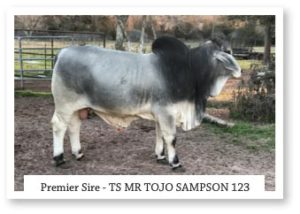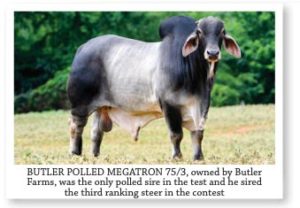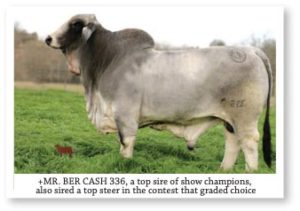The ABBA E.A.R. program, or National Carcass Evaluation Program, was initiated in 2000 to collect feeding and carcass data, including the Warner-Bratzler Shear Force Test for tenderness, on purebred Brahman steers. This data is used to develop the carcass merit and tenderness EPDs used by the ABBA.
There are four traits that are used in the index: Average Daily Gain (ADG), Ribeye Area per Hundredweight of Carcass (REA/CWT), Marbling Score (MS), and Shear Force (SF). The index uses ratios of these traits rather than the actual value so that extremes in any given trait have less influence overall. The trait ratios are weighted as follow: 20% for ADG, 30% for REA/CWT, 30% for MS and 20% for SF.
If you had followed past carcass tests you might remember that the weighting of the traits was different in year’s past. During the history of the E.A.R. program this weighting has been changed at least once. Several years ago, REA/CWT was substituted for REA to reduce the influence of heavier carcasses. The reason for this change is that heavier carcasses would typically also have larger REA.

This year’s Top Producer Award went to Todd Schindler of TS Cattle Company. The Top Producer award is for the producer who had the best group of five (5) steers. Schindler had the best group of five steers and the sire of those steers also helped Schindler win the Premier Sire Group award, as that award is presented to the Brahman sire of the best three (3) steers in the program. All of Schindler’s steers this year were sired by TS MR TOJO SAMPSON 123, who was sired by CRR MR. SUGAR 142 and is out of 120 ARMI DE CABALLO ROJO.
“While it is an honor to win this year’s contest, we enter cattle in the carcass contest not necessarily to win it, but to make sure we are not making a breeding mistake,” explained Schindler. “If you think about it once you get the results from this year’s contest you have the siblings being born the same year, you have the siblings that are coming yearlings, and you have calves inside of cows to be born that year. If that bull has horrible carcass traits, the breeder is setting his herd, and the herds of the customers he sells to, back for years, if not decades. As an added benefit the test also helps us identify quality carcass females/dams by entering and comparing their offspring from the same sires, under the same conditions.”
Another benefit of the test is that USDA quality grade, assigned by a USDA grader in plant, is given to every steer in the program. While all the data that is gathered on steers in the program is useful, this is a very important piece of information that helps producers identify sires and dams in their herd that have the potential to grade better than other cattle in their herd.
There are three quality grades of beef. Prime beef has abundant marbling; choice beef is high quality, but has less marbling than prime; select beef is very uniform in quality and normally leaner than the higher grades. Recently in the marketplace, there has been increased emphasis on improving the quality and consistency of beef. So many packers have initiated value-based pricing methods, commonly referred to as grid pricing. This means price is established on each individual animal based on carcass merit. So in the current marketplace it is being made clear, better carcass traits, such as quality grade, will bring more to your bottom line. Consequently, it is important as a breed that we pinpoint genetics that will help to continue to improve our carcass qualities.
Some of the top steers in the 2019 program also had some of the highest grading qualities and graded choice.
These steers came from three different Brahman breeders that were participating in the contest. TS MR TOJO CALVIN 234 graded choice and won the Top Overall Steer Award for Schindler’s TS Cattle Company.
Second Overall Steer was BUTLER PRIMO 108 sired by *LRSFE MR ELDORADO BUTLER WELL and out of BUTLER PRIMA 50 (S). Rick Butler of Butler Farms entered BUTLER PRIMO 108 into the contest as one of his entries. Butler has participated in every carcass contest and bull test since the ABBA started the programs.

When asked why he has participated in all the programs since inception Butler explained, “I want data. Data about my herd and which animals I should be breeding to improve the carcass quality of the cattle in my herd. I want to know the relevance of my cattle to the beef industry. With data I can make changes and modifications to my breeding program. My slogan is ‘Keep the Quality Up’ and that is the only way to improve the quality of your herd, is to test, get the data from the test and then make any changes necessary to improve.”

Another top steer that graded choice was an entry of Barry and Charolette Smith’s Bulls Eye Ranch. MR BER 558 was sired by +MR. BER CASH 336 and out of MISS BER 327.
Barry Smith feels strongly about the value and the importance of participating in the ABBA Performance programs. “As a breed we have to continue to strive to improve our herds,” explains Smith. “When our bull +MR. V8 670/6 won the Overall High Indexing Sire in the 2015 test we used that information as well as other data we had collected on our herd to make some breeding decisions. We continue to participate in the tests so we can learn more about our cattle. At the end of the day what really matters is how can we as a breed improve our beef quality so we can sell our product without getting discounted at the feed lot.
Communication and messaging are key in this age of the 24-hour news cycle and information overload. There are factors that Brahman cattle excel at, such as average daily gain, feed conversion, and yield grade. We need to tell the story over and over about all the positive attributes of Brahman cattle, while also looking at ways to better identify the performance-oriented genetics within our cattle herds and continuing to improve the breed. Additionally, we as a breed should be spreading the news about not only these positive factors, but also the health benefits of Brahman beef.
Beef is an excellent source of vitamin B12 and a good source of protein, iron, zinc and other nutrients. Don’t take our word for it, this is according to the U.S. Department of Agriculture. This could be a reason many consumers want to eat more beef and are looking for sources of healthier beef.
According to a recent article on FeedStuffs website, Dr. Raluca Mateescu, an Associate Professor of Animal Science at the University of Florida, said her research showed that consumers might even pay up to $1.50/lb. more for healthier beef. Researchers have found that saturated fats declined from 51.3% to 47.5% and polyunsaturated fats increased from 4.3% to 6.9% in Brahman versus Angus cattle. So, they found that Brahman is a healthier source of meat.
“Research in the last decade shows the amount of fat in the diet is not really linked with diseases,” Mateescu said. “What is becoming clearer is that bad fats — meaning trans and short-length saturated fats — increase the risk for coronary heart disease and other diseases, while good fats — meaning mono- and polyunsaturated and longer-length saturated fats — lower this risk. The key to a healthy diet is not to reduce total fat intake but to substitute bad fats for good fats.”
Yet feed lots and packers continue to discount the prices on Brahman cattle. Maybe consumers and the packing plants have not heard the news about the health benefits of Brahman beef. So not only do we need to spread the word about the health benefits of Brahman beef, but we need to continue as a breed to improve the beef quality of our cattle.
The saying “perception is reality” can be used to justify an opinion that may be unjustifiable or out of touch with reality.
The saying “perception is reality” can be used to justify an opinion that may be unjustifiable or out of touch with reality. Unfortunately, there are some factors, as well as some unjustifiable myths, that can cause discounts at the sale barn for Brahman cattle. Such as all Brahmans have bad temperaments, lack tenderness or most importantly, the idea that they lack marbling. Other breeds have these same problems, but the perception of these factors in the Brahman breed continues to cause larger discounts at the sale barn.
If that leads you to the question, “What can we do about it?” then you are the very breeder that should participate in these important ABBA performance programs. So if you have not previously participated in one of the ABBA’s programs, we encourage you to do so, as they are very beneficial programs that provide a lot of data to producers, the ABBA and ultimately will help the Brahman breed in the beef industry.
The ABBA has done a phenomenal job with the show ring, junior program, international programs and promotion, as well as their development of the F1 program. The attention to these programs has helped the Brahman breed achieve great value throughout the years and many breeders have taken advantage and participated in these programs. Unfortunately, not as many breeders take advantage of the performance contest and testing opportunities that the ABBA provides to its members through both the Carcass Test (E.A.R. Program) and the ABBA Performance Bull Test. Since data collection is so important currently, we hope more breeders will become involved in the ABBA’s performance programs.
Some breeders in the past may have viewed taking part in these programs as an opportunity for winning a trophy and decided not to participate. In reality it is better to view the performance programs as opportunities to learn more about what is under the hide of your cattle and use the data you receive as a tool in your breeding decisionmaking process.
Others might have thought it was too hard to get ready for or too difficult to keep track of the time line necessary to prepare your cattle to be part of the program. The Brahman Journal may not be able to assist in getting your cattle ready for one of these programs, but we will be able to provide some time lines for cattle preparation for future participation in these programs. Look to the March edition for an article with a time line for both programs and what needs to be done to participate in future programs. We will also have those times lines posted on our calendar-style Brahman event website.
Brahman breeders should applaud the current and past performance committees and executive directors for starting these programs and continuing these programs. They knew the goal and purpose of these programs was not to win a trophy, but rather to find the animals in your herd that will help change the performance and perception of the Brahman breed.
So if you have not previously participated in one of the ABBA’s programs, we encourage you to do so, as they are very beneficial programs that provide a lot of data to producers. Remember knowledge is power.














